Function Observer Based Event-triggered Control for Linear Systems with Guaranteed L∞-Gain
I. INTRODUCTION
Awide variety of today's engineering applications
are implemented on digital platforms. In such an implementation, the
sampled-data control theory has shown its effectiveness and
developed considerably well as shown[1, 2]. However, in these
traditional sampled-data control frameworks, the control task is
executed periodically regardless whether it is really required or
not. Besides, the sampling period is chosen for a worst-case
scenario, thus leading to conservatism. Moreover, these attributes
arising from communication constraints of real networks lead to
unnecessary utilization of channel and power consumption. Since the
desired control specification cannot always be ensured using a fixed
sampling period, the current trend is to adopt event-triggered
control, see, e.g., [3, 4, 5]. These papers highlighted the advantages
of event-triggered control and proposed systematic design methods,
thus motivated the development of this theory.
Event-triggered control offers clear advantages with respect to
traditional periodic control but at the same time introduces new
practical problems, that is, it needs a special hardware as an
event detector to decide the next sample time. Unfortunately,
using this kind of hardware, such as field programmable gate array
(FPGA), is not practical in many engineering applications.
Therefore, an alternative approach called self-triggered control
appears. Both the event-triggered control and self-triggered
control have two basic components. A controller that computes the
control input and a triggering mechanism that decides the control
task release time. But the difference is that, in a self-triggered
strategy[6], the next release time is computed using the
current sampled data and dynamics of the plant.
Since [4] obtained results on event-triggered control under the
assumption that feedback control law preserves input-to-state
stability with respect to measurement error of the plant state,
fruitful results appear, see, e.g., [7, 8, 9, 10, 11]. Self-triggered
control of homogeneous control systems was investigated[7]and
self-triggered scheme guaranteeing finite-gain $\mathcal{L}_2$
stability was presented[8].
Most of the prior work on event-triggered and self-triggered
control has a common assumption, that is, the full state
information is available. However, in practice, the full state is
often not available for measurement. Thus, it is important to
extend to event-triggered output-based control with/without an
observer.
A dynamic output-feedback controller based on event-triggered
control was implemented in [12], while an event condition based on
the state error of the observer was proposed and the system with
norm-bounded uncertainty was investigated in [13]. A more recent
work can be found in [14], which used the hybrid system method
proposed in [15]. In the work, the event-triggered systems is
reformulated as a hybrid dynamical system and linear matrix
inequalities are applied to study its stability and performance.
In [16], observer-based event-triggered control was considered,
and global uniform ultimate bounded stability of the
event-triggered system was obtained.
Inspired by [14] and [16], we propose an event-triggered control
strategy which is based on a function observer. Actually, in many
engineering applications, the purpose of getting the estimate of
state is to generate a feedback control law. Thus, in this
situation, it is better to generate a linear combination of the
state rather than to generate the estimate of the plant state. We
will show that, in case we skip the intermediate procedure of
generating estimate of the state, and directly transmit the
estimate of the linear combination of state to the plant as
control input, we will have better control performance and less
numbers of sampling events.
The rest of this paper is organized as follows: we first introduce
some notations and background on hybrid systems in Section II; and
then, the problem formulation is stated in Section III, besides,
the event-triggered mechanism and closed-loop model are presented
in this section; two approaches are, proposed, to, analyze,
the event-triggered, control, system, in Section IV, with
guaranteed positive minimum inter-event time; a numerical example
is illustrated in Section V; finally, Section VI summarizes the
main results.
II. NOTATIONS AND PRELIMINARIES
As usual, we shall use the notation $\| \cdot \|$ to denote the
Eucli- dean norm of an element $x \in {\bf R}^n$. ${\bf R}^n$
denotes the $n$-dimensional Euclidean space and ${\bf R}^{m \times
n}$ denotes the set of all $m \times n$ dimensional real matrices.
${\bf R}^+$ denotes the set of positive real numbers. For real
matrix $X$, $X^{\rm T}$ and $X^{-1}$ are defined as the transpose
and inverse of $X$. And $\lambda_{\rm min}(X)$ and $\lambda_{\rm
max}(X)$ denotes the smallest and the largest eigenvalue of $X$,
respectively. $X \succ Y, (X \prec Y)$ indicates that $X-Y$ is a
positive (negative) definite matrix. Besides, $X \nprec Y$ denotes
that $X-Y$ is not negative definite. Finally, for a signal $x$, we
denote the limit from above at time $t \in {\bf R}^+$ by
$x^+(t)=\lim_{h \rightarrow 0^+}x(t+h)$.
${\bf Definition 1.}$[15] Consider a hybrid system
$\mathcal{H}$ with the form
|
\begin{align}
\begin{array}{lll}
\dot{x} \in \mathcal{F}(x), & x \in \mathcal{C}, \\
x^+ \in \mathcal{G}(x), & x \in \mathcal{D},
\end{array}
\end{align}
| (1) |
where $\mathcal{C}$ is called the flow set, $\mathcal{F}$ the flow
map, $\mathcal{D}$ the jump set, and $\mathcal{G}$ the jump map.
Besides, let $\mathcal{A} = \mathcal{C} \lor \mathcal{D}$, thus $x
\in \mathcal{A}$.
A compact set $\mathcal{S} \subseteq \mathcal{A}$ is stable for
$\mathcal{H}$ if for each $\epsilon > 0$ there exists $\delta > 0$
such that $\min \{ \|x(0)-y \|:y \in \mathcal{S} \} \le \delta$
implies $\min \{ \|x(t)-y \|:y \in \mathcal{S} \} \le \epsilon$.
A compact set $\mathcal{S}$ is attractive if there exists a
neighborhood of $\mathcal{S}$ from which each solution is bounded
and converges to $\mathcal{S}$, that is, $\lim_{t \rightarrow
\infty}{\min \{ \|x(t)-y \|:y \in \mathcal{S} \}}=0$.
A compact $\mathcal{S}$ is asymptotically stable if it is stable
and attractive.
${\bf Lemma 1}$[15]. Consider the hybrid system $\mathcal{H}$
defined in Definition 1. The compact set $\mathcal{S}$ satisfies
$\mathcal{G}(\mathcal{S} \land \mathcal{D}) \subset \mathcal{S}$.
If there exists a Lyapunov function candidate $V(x)$ for
$(\mathcal{H}, \mathcal{S})$ such that
|
\begin{align}
&\dot{V}(x)<0, \quad \textrm{for all}~x \in \mathcal{C} \setminus \mathcal{S}, \nonumber \\
&V(\mathcal{G}(x))-V(x)<0, \quad \textrm{for all}~x \in
\mathcal{D} \setminus \mathcal{S},
\end{align}
| (2) |
then the set $\mathcal{S}$ is asymptotically stable.
III. PROBLEM FORMULATION
Consider the following linear time-invariant system with the
initial state $x(t_0)=x_0$ that satisfies, for all $t\ge t_0$,
|
\begin{align}
\left\{ \begin{array}{l}
\dot{x}=Ax+Bu+H\omega, \\
y=Cx,
\end{array} \right.
\end{align}
| (3) |
where $x \in {\bf R}^n$, $y \in {\bf R}^q$, $u \in {\bf R}^p$ and
$\omega \in {\bf R}^r$ denote the state, output, control input and
unknown disturbance, respectively. The pairs $(A, B )$ and $(A, C)$
are assumed to be controllable and observable, respectively.
In this paper we focus on event-triggered control strategies that
can be described with the help of Fig. 1. In this setup, the plant
output $y$ is sampled only at the time instants $t_k, k \in {\bf
N}$. This information $\hat{y}(t_k)$ is sent to a function
observer (we can see a book on linear systems for more details, for example, see [17]), %\cite{Zheng})
which is described by the following equation in the interval
$[t_k, t_{k+1})$,
|
\begin{align}
\left\{ \begin{array}{lll}
\dot{z}\!\!\!\!&=&\!\!\!\!Fz+Nu+G\hat{y}, \\
w\!\!\!\!&=&\!\!\!\!Ez+M\hat{y},
\end{array} \right.
\end{align}
| (4) |
where $z \in {\bf R}^n$ and $w \in {\bf R}^p$ denote the state and
output of the function observer, respectively. Besides, all the
eigenvalues of $F$ have negative real part.
If we have that $\lim_{t \rightarrow \infty}(Px(t)-z(t))=0$, where
$P$ is chosen satisfying $PA-FP=GC$, $K=EP+MC$, $N=PB$, then we
can get
|
\begin{align}
\lim_{t \rightarrow \infty}(Kx(t)-w(t))=0.
\end{align}
| (5) |
The gain matrix $K$ is designed using an emulation-based
approach, that is, it is chosen such that asymptotical stability
is guaranteed for a continuous-time controller with access to full
state measurements. The function observer computes an estimate of
the signal $Kx$ at the current sampling time. This estimated value
will be sampled at $t_k$, and then be sent to the plant as a
control input. The control input is kept constant between sampling
time by a zero-order hold, thus,
|
\begin{align}
u(t)=\tilde{w}(t_k), t \in [t_k, t_{k+1}).
\end{align}
| (6) |
Here, $t_k$ is the time when the event happens.
Define the event-triggered-induced errors as
|
\begin{align}
\hat{e}(t)=\hat{y}(t_k)-y(t) \quad \textrm{and} \quad
\tilde{e}(t)=\tilde{w}(t_k)-w(t),
\end{align}
| (7) |
and select the event-triggering mechanism satisfying
|
\begin{align}
&t_{k+1}=\inf\{t>t_k | , \|\hat{e}(t)\|^2=\sigma\|y(t)\|^2+\epsilon, \nonumber \\
&\qquad \quad \textrm{or} \quad
\|\tilde{e}(t)\|^2=\zeta\|w(t)\|^2+\delta \}
\end{align}
| (8) |
for some $\sigma, \epsilon, \zeta, \delta \ge 0$, and suppose
$t_0=0$. Let the observation error be defined as
$e(t)=Px(t)-z(t)$. Thus, the resulting closed-loop system becomes:
|
\[\left\{ {\begin{array}{*{20}{l}}
{\dot x}& = &{(A + BMC)x + BEz + BM\hat e + B\tilde e + H\omega , }\\
{\dot z}& = &{(NM + G)Cx + (F + NE)z}\\
{}&{}&{ + (NM + G)\hat e + N\tilde e, }\\
{\dot e}& = &{Fe - G\hat e + PH\omega .}
\end{array}} \right.\]
| (9) |
The problem addressed here aims at developing conditions on
event-triggered control strategy in terms of linear matrix
inequalities that renders the closed-loop system satisfying
specified stability, which depends on the method employed.
Actually, we will use two methods to analyze this system by
deriving conditions such that the closed-loop system is
asymptotically stable in a compact set and ultimate bounded
stable, respectively.
${\bf Remark 1.}$ The event-triggering mechanism proposed above in
(8) requires that it is feasible to transmit both $y$ and $w$
synchronically. The transmitted $w$ should be computed based on
the newly received $\hat{y}$. To explain this requirement in more
detail, let us consider the opposite case, i.e., the two signals
are not transmitted synchronically.
From the event-triggered conditions in (8), we could find that the
thresholds are reached in turn, and $y$ and $w$ are triggered to
be sent more and more frequently as $\hat{y}$ has a direct
influence on $w$. Therefore, it could happen that $y$ or $w$ are
transmitted twice or more at one time instant, and this cannot be
implemented from a practical point of view.
IV. EVENT-TRIGGERED CONTROL DESIGN
A. Hybrid Dynamical System Method
In this section, we reformulate the event-triggered control system
using the method in [15], $%\cite{Teel Hyb}$,
thus get a hybrid system model satisfying the following set of
state equations,
|
\[\begin{array}{*{20}{l}}
{\dot \chi }& = &{\tilde A\chi + \tilde H\omega , }&{{\rm{when}}\;\chi \in {{\cal S}_F}, }\\
{{\chi ^ + }}& = &{\tilde B\chi , }&{{\rm{when}}\;\chi \in {{\cal S}_J}, }
\end{array}\]
| (10) |
where
|
\[\tilde A = {\left[{\begin{array}{*{20}{l}}
{\tilde A_1^{\rm{T}}}&{\tilde A_2^{\rm{T}}}&{\tilde A_3^{\rm{T}}}&{\tilde A_4^{\rm{T}}}&{\tilde A_5^{\rm{T}}}
\end{array}} \right]^{\rm{T}}}, \]
| (11) |
with
|
\[\begin{array}{*{20}{l}}
{{{\tilde A}_1} = \left[{\begin{array}{*{20}{l}}
{A + BMC}&{BE}&0&{BM}&B
\end{array}} \right], }\\
{{{\tilde A}_2} = \left[{\begin{array}{*{20}{l}}
{(NM + G)C}&{F + NE}&0&{NM + G}&N
\end{array}} \right], }\\
{{{\tilde A}_3} = \left[{\begin{array}{*{20}{l}}
0&0&F&{ - G}&0
\end{array}} \right], }\\
{{{\tilde A}_4} = - C{{\tilde A}_1}, \quad {{\tilde A}_5} = - E{{\tilde A}_2}, }
\end{array}\]
|
and
|
\[\tilde H = {\left[{\begin{array}{*{20}{l}}
{{H^{\rm{T}}}}&0&{{H^{\rm{T}}}{P^{\rm{T}}}}&{ - {H^{\rm{T}}}{C^{\rm{T}}}}&0
\end{array}} \right]^{\rm{T}}}, \]
| (12) |
|
\[\tilde B = \left[{\begin{array}{*{20}{l}}
I&0&0&0&0\\
0&I&0&0&0\\
0&0&I&0&0\\
0&0&0&0&0\\
0&0&0&0&0
\end{array}} \right].\]
| (13) |
In the above equations, $\chi \in \mathcal{A} \subseteq {\bf
R}^{n_\chi}$ denotes the state vector of the system.
$\mathcal{S}_F \subseteq {\bf R}^{n_\chi}$ and $\mathcal{S}_J
\subseteq {\bf R}^{n_\chi}$ denote the flow and jump set,
respectively. Besides, let $\mathcal{A}=\mathcal{S}_F \lor
\mathcal{S}_J$. For notational convenience the state components of
$\chi$ will be denoted as two groups, that is, $\chi_x$ and
$\chi_e$
|
\[\chi = {\left[{\begin{array}{*{20}{c}}
{{x^{\rm{T}}}}&{{z^{\rm{T}}}}&{{e^{\rm{T}}}}&{{{\hat e}^{\rm{T}}}}&{{{\tilde e}^{\rm{T}}}}
\end{array}} \right]^{\rm{T}}} = {\left[{\begin{array}{*{20}{l}}
{\chi _x^{\rm{T}}}&{\chi _e^{\rm{T}}}
\end{array}} \right]^{\rm{T}}}.\]
| (14) |
The flow set is
|
\begin{align}
\mathcal{S}_F=\{\chi \in {\bf R}^{n_\chi}| \chi^{\rm T} Q_y
\chi<\epsilon ~, \textrm{and} ~,
\chi^{\rm T} Q_w \chi<\delta \},
\end{align}
| (15) |
and the jump set is
|
\begin{align}
\mathcal{S}_J=\{\chi \in {\bf R}^{n_\chi}| \chi^{\rm T} Q_y
\chi=\epsilon ~, \textrm{or} ~,
\chi^{\rm T} Q_w \chi=\delta \},
\end{align}
| (16) |
where
|
\begin{align}
Q_y=\left[
\begin{array}{cllll}
-\sigma C^{\rm T} C & 0 & 0 & 0 & 0\\
0 & 0 & 0 & 0 & 0\\
0 & 0 & 0 & 0 & 0\\
0 & 0 & 0 & I & 0\\
0 & 0 & 0 & 0 & 0
\end{array}
\right],
\end{align}
| (17) |
|
\begin{align}
Q_w=\left[
\begin{array}{cl}
-\zeta Q_0 & 0\\
0 & I
\end{array}
\right],
\end{align}
| (18) |
and
|
\begin{align}
Q_0=\left[
\begin{array}{llll}
C^{\rm T} M^{\rm T} MC & C^{\rm T} M^{\rm T} E & 0 & C^{\rm T} M^{\rm T} M\\
E^{\rm T} MC & E^{\rm T} E & 0 & E^{\rm T} M\\
0 & 0 & 0 & 0\\
M^{\rm T} MC & M^{\rm T} E & 0 & M^{\rm T} M
\end{array}
\right].
\end{align}
| (19) |
Let us now define the notion of $\mathcal{L}_\infty$-gain of a
system, and for which we introduce a performance output $z_p \in
{\bf R}^m$ given by
|
\begin{align}
z_p = C_z \chi + D_z \omega.
\end{align}
| (20) |
${\bf Definition 2.}$ The $\mathcal{L}_\infty$-gain of the system
(10), with (20) is defined as
|
\begin{align}
\kappa = &\inf \{ \bar{\kappa} \in {\bf R}^+ ~|~ \exists \delta:
\mathcal{A}\rightarrow{\bf R}^+, ~\textrm{such that}
~\|z_p\|_{\mathcal{L}_\infty} \nonumber \\ &\leq \bar{\kappa}
\|\omega\|_{\mathcal{L}_\infty} + \delta(\chi(0)), ~\forall \chi(0)
\in \mathcal{A}, ~\omega \in \mathcal{L_{\infty}} \},
\end{align}
| (21) |
where $z_p$ is given by ~(20), in which $\chi$ is a solution to
~(10), with initial condition $\chi(0) \in \mathcal{A}$ and
disturbance $\omega \in \mathcal{L}_\infty$.
${\bf Theorem 1.}$ Consider the event-triggered control system (10),
with (11), (12), (13), (15), (16) and (20) and assume its
solutions exist for all $t \in {\bf R}^+$ and all $\omega \in {\bf
R}^r$, satisfying $\|\omega\|_{\mathcal{L}_\infty} < \infty$.
Moreover, assume that a minimum inter-event time $\tau > 0$
exists. Now suppose there exist a positive definite matrix $P_x
\in {\bf R}^{(n_x+n_z+n_e) \times (n_x+n_z+n_e)}$, a positive
semidefinite matrix $P_\chi \in {\bf R}^{n_\chi \times n_\chi}$,
and $\tilde{P}:={\rm diag}\{P_x, 0\}+P_\chi$, scalars ~$\kappa,
~\iota, ~\theta
> 0$ and ~$\lambda_1, ~\lambda_2, ~\lambda_3 > 0$, satisfying
|
\[\left[{\begin{array}{*{20}{c}}
{{{\tilde A}^{\rm{T}}}\tilde P + \tilde P\tilde A + \theta \tilde P - {\lambda _1}{Q_y} - {\lambda _2}{Q_w}}& * \\
{{{\tilde H}^{\rm{T}}}\tilde P}&{ - \iota I}
\end{array}} \right]\underline \prec 0, \]
| (22) |
|
\[{\tilde B^{\rm{T}}}\tilde P\tilde B - \tilde P + {\lambda _3}{Q_y}\underline \prec 0, \]
| (23) |
|
\[{\tilde B^{\rm{T}}}\tilde P\tilde B - \tilde P + {\lambda _3}{Q_w}\underline \prec 0, \]
| (24) |
|
\[\left[{\begin{array}{*{20}{c}}
{\theta \tilde P}&*&*\\
0&{({\kappa ^2} - \iota )I}&*\\
{{C_z}}&{{D_z}}&I
\end{array}} \right]\underline \succ 0.\]
| (25) |
Then,
|
\begin{align}
\mathcal{S} = \left\{ \chi \in \mathcal{S}_F \lor \mathcal{S}_J
~\Big|~ \chi^{\rm T} \tilde{P} \chi \leq \frac{\lambda_1 \epsilon
+ \lambda_2 \delta}{\theta} \right\}
\end{align}
| (26) |
is a globally asymptotically stable set for (10) with $\omega =
0$. Moreover, the $\mathcal{L}_\infty$-gain of (10) is smaller
than or equal to $\kappa$ and $\delta(\chi(0))$ in (21) can be
taken as $\delta(\chi(0)) = (\theta\chi^{\rm T}(0)\tilde{P}\chi(0)
+ \lambda_1\epsilon + \lambda_2\delta)^{1/2}$.
$\textbf{Proof.}$ Define $V(\chi)=\chi^{\rm T} \tilde{P} \chi$, then
we have $\dot{V}(\chi)=\dot{\chi}^{\rm T} \tilde{P} \chi + \chi^{\rm
T} \tilde{P} \dot{\chi}$. Using (22)-(24), it can be rewritten as
|
\begin{align*} \dot{V}(\chi) \le -\theta
V(\chi)+\lambda_1\epsilon+\lambda_2\delta + \iota\|\omega\|^2, t
\in (t_k, t_{k+1}].
\end{align*}
|
Using the Comparison Lemma, we can
observe that the inequality above implies that
|
\begin{align}
&V(\chi(t)) \leq {\rm e}^{-\theta(t-t_k)} V(\chi^+(t_k)) +
\int^{T}_{t_k}
{\rm e}^{-\theta(t-s)} \big( \iota\|\omega(s)\|^2 \nonumber \\
& \qquad +\lambda_1\epsilon + \lambda_2\delta \big){\rm d}s, ~t \in
(t_k, t_{k+1}], ~k \in {\bf N}.
\end{align}
| (27) |
From (23) and (24), we can get
|
\begin{align*}
&V(\tilde{B}\chi)-V(\chi)\le
-\lambda_3\epsilon, \\
&V(\tilde{B}\chi)-V(\chi)\le -\lambda_3\delta.
\end{align*}
|
Using $V(\tilde{B}\chi)-V(\chi)\le 0$ and (27) repeatedly, and the
fact that $\{ t_k | k \in {\bf N} \}$ does not have accumulation
points, we obtain that
|
\begin{align}
&V(\chi(t)) \leq {\rm e}^{-\theta t} V(\chi(0)) + \int^{T}_0 {\rm
e}^{-\theta(t-s)}
\big( \iota \|\omega(s)\|^2 \nonumber \\
&\qquad +\lambda_1\epsilon + \lambda_2\delta \big){\rm d}s, ~t \in
{\bf R}^+. \nonumber
\end{align}
|
And thus,
|
\begin{align}
V(\chi(t)) \leq {\rm e}^{-\theta t} V(\chi(0)) +
\frac{\lambda_1\epsilon + \lambda_2\delta}{\theta} +
\frac{\iota}{\theta} \|\omega\|^2_{\mathcal{L}_\infty}.
\end{align}
| (28) |
Observe that (25) implies that
|
\begin{align}
\|z_p(t)\|^2 \leq \theta V(\chi(t)) + (\kappa^2 - \iota)
\|\omega(t)\|^2,
\end{align}
| (29) |
and that $\kappa^2 \ge \iota$. We substitute (28) into (29) and
observe that $\|\omega(t)\| \le \|\omega\|_{\mathcal{L}_\infty}$
for all $t \in {\bf R}^+$, yielding
|
\begin{align}
\|z_p(t)\|^2 \le \theta {\rm e}^{-\theta t} V(\chi(0)) +
\lambda_1\epsilon + \lambda_2\delta +
\kappa^2\|\omega\|^2_{\mathcal{L}_\infty}, t \in {\bf R}^+.
\end{align}
| (30) |
Taking now the supremum of the left and the right-hand side of
(30) over all time $t \in {\bf R}^+$, we have that
|
\[\parallel {z_p}\parallel _{{{\cal L}_\infty }}^2 \le \delta {(\chi (0))^2} + {\kappa ^2}\parallel \omega \parallel _{{{\cal L}_\infty }}^2 \le {(\delta (\chi (0)) + \kappa \parallel \omega {\parallel _{{{\cal L}_\infty }}})^2}\]
|
with $\delta(\chi(0))$ as defined in the hypothesis of the theorem.
This shows that the $\mathcal{L}_\infty$-gain is smaller than
$\kappa$.
$\square$
As a specific example, let us consider the case in which the
disturbance equals zero, that is $\omega = 0$. Therefore, we can
obtain the next corollary.
${\bf Corollary 1.}$ Consider the event-triggered control system given
by (10), with (11), (13), (15) and (16) and assume its solutions
exist for all $t \in {\bf R}^+$. Moreover, suppose there exist a
positive definite matrix $P_x \in {\bf R}^{(n_x+n_z+n_e) \times
(n_x+n_z+n_e)}$, a positive semidefinite matrix $P_\chi \in {\bf
R}^{n_\chi \times n_\chi}$, and $\tilde{P}:={\rm
diag}\{P_x, 0\}+P_\chi$, scalars $\theta >0, \lambda_1>0,
\lambda_2>0, \lambda_3>0$, satisfying
|
\[{{\tilde A}^{\rm{T}}}\tilde P + \tilde P\tilde A + \theta \tilde P - {\lambda _1}{Q_y} - {\lambda _2}{Q_w}\underline \prec 0, \]
| (31) |
|
\[{{\tilde B}^{\rm{T}}}\tilde P\tilde B - \tilde P + {\lambda _3}{Q_y}\underline \prec 0, \]
| (32) |
|
\[{{\tilde B}^{\rm{T}}}\tilde P\tilde B - \tilde P + {\lambda _3}, {Q_w}\underline \prec 0, \]
| (33) |
then, $\mathcal{S}=\{\chi \in \mathcal{S}_F \lor
\mathcal{S}_J~|~\chi^{\rm T} \tilde{P}\chi \le \frac{\lambda_1
\epsilon + \lambda_2 \delta}{\theta}\}$ is a globally
asymptotically stable set for the system (10).
${\bf Remark 1.}$ In Theorem 1, we assume that there exists a
minimum inter-event time $\tau>0$, and its proof is given in the
next theorem. From the expression of $\mathcal{S}$ we can see that
$\epsilon$ and $\delta$ are parameters influencing the
asymptotically stable set. Small $\epsilon$ and $\delta$ will lead
to better performance, with the cost of stricter event-triggered
mechanism and more transmissions.
${\bf Theorem 2.}$ Consider the event-triggered control system (10),
with (11), (12), (13), (15), (16) and (20). For every initial
condition $\chi(0)$ satisfying $\|\chi(0)\| \le a$ and every
disturbance $\omega \in {\bf R}^r$ satisfying $\|\omega\| \le b$,
there exists a nonzero minimum inter-event time $\tau$, i.e.,
$t_{k+1}-t_k \ge \tau > 0$, for all $k \in {\bf N}$. An explicit
expression for a lower bound on $\tau$ is given by
|
\begin{align}
\min \bigg\{ \tau > 0 \Big| \lambda_{\max} \Big( \Big[
\begin{array}{c} I\\0 \end{array} \Big]^{\rm T} {\rm e}^{\tilde{A}^{\rm
T} \tau} Q_y {\rm e}^{\tilde{A} \tau} \Big[\begin{array}{c} I\\0
\end{array} \Big] \Big)
\ge \frac{\zeta_y(\tau)}{\xi} \nonumber \\
\textrm{or} \quad \lambda_{\max} \Big( \Big[\begin{array}{c} I\\0
\end{array} \Big]^{\rm T} {\rm e}^{\tilde{A}^{\rm T} \tau} Q_w {\rm e}^{\tilde{A} \tau}
\Big[\begin{array}{c} I\\0 \end{array} \Big] \Big) \ge
\frac{\zeta_w(\tau)}{\xi} \bigg\},
\end{align}
| (34) |
in which
|
\[{\zeta _y}(\tau ) = - \parallel {Q_y}\parallel (\rho (\tau ) + 2\sqrt {\xi \rho (\tau )} \parallel {{\rm{e}}^{\tilde A\tau }}\tilde B\parallel ), \]
| (35) |
|
\[{\zeta _w}(\tau ) = \delta - \parallel {Q_w}\parallel (\rho (\tau ) + 2\sqrt {\xi \rho (\tau )} \parallel {{\rm{e}}^{\tilde A\tau }}\tilde B\parallel ), \]
| (36) |
|
\[\xi = \frac{{{\lambda _{\max }}(\tilde P)\theta {a^2} + \iota {b^2} + {\lambda _1} + {\lambda _2}\delta }}{{\theta {\lambda _{\min }}({P_x})}}, \]
| (37) |
|
\[\rho (\tau ) = \tau \int_0^\tau {{{\rm{e}}^{{\lambda _{\max }}({{\tilde A}^{\rm{T}}} + \tilde A)s}}} {\rm{d}}s\parallel \tilde H{\parallel ^2}{b^2}.\]
| (38) |
$\textbf{Proof.}$ In the proof of this theorem, we will temporarily
introduce notations $Q_i, \zeta_i$ and $\epsilon_i$, in which $i =
y, w$. That means $\epsilon_y = \epsilon$ and $\epsilon_w =
\delta$. At the start of computing a guaranteed $\tau > 0$, we
compute the event time $t_{k+1}$ given by (8), which can be
expressed as
|
\[{t_{k + 1}} = \inf \left\{ {t > {t_k}\left| {{{\left[ {\begin{array}{*{20}{c}}
{{\chi _x}}\\
{{\chi _e}}
\end{array}} \right]}^{\rm{T}}}{Q_i}\left[ {\begin{array}{*{20}{c}}
{{\chi _x}}\\
{{\chi _e}}
\end{array}} \right] = \epsilon_i} \right.} \right\}.\]
|
Solving the differential equation $\dot{\chi} = \tilde{A}\chi +
\tilde{H}\omega$, we can get the solution
|
\[\chi = {{\rm{e}}^{\tilde A(t - {t_k})}}\chi ({t_k}) + \int_{{t_k}}^T {{{\rm{e}}^{\tilde A(t - s)}}} \tilde H\omega (s){\rm{d}}s.\]
|
Substitute it into $\chi^{\rm T} Q_i \chi < \epsilon_i$, yielding
|
\begin{align}
&\Big({\rm e}^{\tilde{A}(t-t_k)}\chi(t_k) + \int^{T}_{t_k}
{\rm e}^{\tilde{A}(t-s)}\tilde{H}\omega(s){\rm d}s \Big)^{\rm T} Q_i \nonumber \\
&\qquad \times \Big({\rm e}^{\tilde{A}(t-t_k)}\chi(t_k) +
\int^{T}_{t_k} {\rm e}^{\tilde{A}(t-s)}\tilde{H}\omega(s){\rm d}s
\Big) < \epsilon_i,
\end{align}
| (39) |
which is equivalent to
|
\begin{align}
&\chi^{\rm T}(t_k) {\rm e}^{\tilde{A}^{\rm T}(t-t_k)} Q_i {\rm e}^{\tilde{A}(t-t_k)} \chi(t_k) \nonumber \\
&\qquad +\int^{ T}_{t_k} \big( \tilde{H}\omega(s) \big)^{\rm T} {\rm
e}^{\tilde{A}^{\rm T}(t-s)}{\rm d}s
Q_i \int^{T}_{t_k} {\rm e}^{\tilde{A}(t-s)}\tilde{H}\omega(s){\rm d}s \nonumber \\
&\qquad +2{\rm e}^{\tilde{A}(t-t_k)}\chi(t_k) Q_i \int^{ T}_{t_k}
\big( \tilde{H}\omega(s) \big)^{\rm T} {\rm e}^{\tilde{A}^{\rm
T}(t-s)}{\rm d}s < \epsilon_i.
\end{align}
| (40) |
Now using Holder's inequality and Wazewski's inequality, we can get
|
\begin{align}
&\|\int^{T}_{t_k} {\rm e}^{\tilde{A}(t-s)} \tilde{H}\omega(s){\rm d}s\|^2 \nonumber \\
&\qquad \le\int^{T}_{t_k} {\rm e}^{\lambda_{\max}(\tilde{A}^{\rm
T}+\tilde{A})(t-s)}{\rm d}s
\int^{T}_{t_k} \|\tilde{H}\omega(s)\|^2 {\rm d}s \nonumber \\
&\qquad \le\int^{t-t_k}_0 {\rm e}^{\lambda_{\max}(\tilde{A}^{\rm T}+\tilde{A})s} {\rm d}s
\int^{T}_{t_k}1{\rm d}s\nonumber \\
& \qquad \times \sup_{s \in (t_k, t]} \|\tilde{H}\omega(s)\|^2.
\end{align}
| (41) |
Hence, the left-hand side of (41) can be upper bounded by
$\rho(t-t_k)$, with $\rho(\cdot)$ defined in (38). Therefore,
|
\begin{align}
& \chi^{\rm T}_x(t_k) \Big[\begin{array}{c} I\\0 \end{array}
\Big]^{\rm T} {\rm e}^{\tilde{A}^{\rm T}(t-t_k)}
Q_i {\rm e}^{\tilde{A}(t-t_k)} \Big[\begin{array}{c} I\\0 \end{array} \Big] \chi_x(t_k) \nonumber \\
&\qquad <\zeta_i(t-t_k),
\end{align}
| (42) |
for $t > t_k$, implying satisfaction of (40). Namely, no events
are triggered as long as (42) is satisfied. From (28) in Theorem
1, we can get
|
\begin{align*}
V(\chi(t)) \le \lambda_{\max}(\tilde{P}) \|\chi(0)\|^2 +
\frac{\lambda_1\epsilon + \lambda_2\delta}{\theta} +
\frac{\iota}{\theta} \|\omega\|^2_{\mathcal{L}_\infty}.
\end{align*}
|
Hence,
|
\begin{align}
&\|\chi_x(t)\|^2
\le\frac{1}{\lambda_{\min}(P_x)} \big( \chi^{\rm T}_x P_x \chi_x + \chi^{\rm T} P_\chi \chi \big) \nonumber \\
&\qquad =\frac{1}{\lambda_{\min}(P_x)} V(\chi(t))\le \xi.
\end{align}
| (43) |
Now the solution to (34) is the smallest value
$\tau_{\min}:=t-t_k$, such that
|
\begin{align}
\chi^{\rm T}_x \Big[\begin{array}{c} I\\0 \end{array} \Big]^{\rm
T} {\rm e}^{\tilde{A}^{\rm T} \tau_{\min}} Q_i {\rm e}^{\tilde{A}
\tau_{\min}} \Big[
\begin{array}{c} I\\0 \end{array} \Big] \chi_x =
\frac{\zeta_i(\tau_{\min}) \|\chi_x\|^2}{\xi}.
\end{align}
| (44) |
Thus, by using equations (43), (44), we can get the conclusion that
(42) is satisfied as long as $t < t_k + \tau_{\min}$, or
equivalently, no events are triggered under these conditions.
$\square$
${\bf Theorem 3.}$ Consider the event-triggered control system given
by (10), with (11), (13), (15) and (16). For every initial condition
$\chi(0)$ satisfying $\|\chi(0)\|\le a$, there exists a time $\tau
\in {\bf R}^+$ such that the inter-event time implicitly defined by
the event-triggering mechanism (8) are lower bounded by $\tau$,
i.e., $t_{k+1}-t_k\ge \tau > 0$, for all $k\in {\bf N}$. And the
lower bound can be described as
|
\begin{align}
\min\bigg\{\tau >0\bigg| \lambda_{\rm max}
\bigg(\left[\begin{array}{l}I\\0 \end{array}\right]^{\rm T} {\rm
e}^{\tilde{A}^{\rm T}\tau}Q_y {\rm
e}^{\tilde{A}\tau}\left[\begin{array}{l}I\\0
\end{array}\right]\bigg)
\ge\frac{\epsilon}{\xi} \nonumber\\
\textrm{or} \quad \lambda_{\rm max}
\bigg(\left[\begin{array}{l}I\\0
\end{array}\right]^{\rm T} {\rm e}^{\tilde{A}^{\rm T}\tau}Q_y
{\rm e}^{\tilde{A}\tau}\left[\begin{array}{l}I\\0
\end{array}\right]\bigg)\ge\frac{\epsilon}{\xi}\bigg\},
\end{align}
| (45) |
where
|
\begin{align}
\xi=\frac{\lambda_{\rm max}(\tilde{P})\theta a^2 + \lambda_1
\epsilon+\lambda_2\delta}{\theta\lambda_{\rm min}(P_x)},
\end{align}
| (46) |
with $\tilde{P}$ and $P_x$ defined in Theorem 1.
$\textbf{Proof.}$ By Theorem 1, we know that
|
\begin{align}
\dot{V}(\chi) \le -\theta V(\chi)+\lambda_1\epsilon+\lambda_2\delta
\end{align}
| (47) |
holds for $t \in (t_k, t_{k+1}]$, $k \in {\bf N}$. Using comparison
lemma, we have
|
\begin{align}
&V(\chi)\le {\rm e}^{-\theta (t-t_k)}V(\chi^+(t_k)) \nonumber\\
&\qquad +\int_{t_k}^{T}{\rm
e}^{-\theta(t-\rho)}(\lambda_1\epsilon+\lambda_2\delta){\rm d}\rho,
\end{align}
| (48) |
$t \in (t_k, t_{k+1}]$, $k \in {\bf N}$. Using (47) and (48)
iteratively, we obtain $V(\chi)\le {\rm e}^{-\theta
t}V(\chi(0))+\int_0^{T} {\rm
e}^{-\theta(t-\rho)}(\lambda_1\epsilon+\lambda_2\delta){\rm d}\rho$,
thus, we have
|
\begin{align}
&V(\chi)\le {\rm e}^{-\theta t}V(\chi (0))+\frac{\lambda_1\epsilon+\lambda_2\delta}{\theta} \nonumber \\
&\qquad \le\lambda_{\rm max}(\tilde{P})
\|\chi(0)\|^2+\frac{\lambda_1\epsilon+\lambda_2\delta}{\theta} \nonumber \\
&\qquad \le\lambda_{\rm
max}(\tilde{P})a^2+\frac{\lambda_1\epsilon+\lambda_2\delta}{\theta}.
\end{align}
| (49) |
Notice that,
|
\[V(\chi ) = {\chi ^{\rm{T}}}\tilde P\chi = \chi _x^{\rm{T}}{P_x}{\chi _x} + {\chi ^{\rm{T}}}{P_\chi }\chi \ge {\lambda _{{\rm{min}}}}({P_x})\chi _x^{\rm{T}}{\chi _x}, \]
|
therefore
|
\begin{align}
\|\chi_x\|^2 \le \xi.
\end{align}
| (50) |
Solving the differential equation $\dot{\chi}=\tilde{A}\chi$ from
$t_k$ to $t>t_k$, we get $\chi={\rm
e}^{\tilde{A}(t-t_k)}\chi^+(t_k)={\rm
e}^{\tilde{A}(t-t_k)}\left[\begin{array}{l}
I\\0\end{array}\right]\chi_x(t_k)$. From (15) we know that, as
long as $t\ge t_k$ satisfies
|
\begin{align*}
\bigg \{\chi_x^{\rm T}(t_k) \left[\begin{array}{l}I\\0\end{array}
\right]^{\rm T} {\rm e}^{\tilde{A}^{\rm T}(t-t_k)}
Q_y {\rm e}^{\tilde{A}(t-t_k)} \left[\begin{array}{l}I\\0\end{array} \right] \chi_x(t_k) < \epsilon \nonumber\\
\end{align*}
|
and
|
\[\chi _x^{\rm{T}}({t_k}){\left[{\begin{array}{*{20}{l}}
I\\
0
\end{array}} \right]^{\rm{T}}}{{\rm{e}}^{{{\tilde A}^{\rm{T}}}(t - {t_k})}}{Q_w}{{\rm{e}}^{\tilde A(t - {t_k})}}\left[{\begin{array}{*{20}{l}}
I\\
0
\end{array}} \right]{\chi _x}({t_k}) < \delta \} , \]
|
no events are triggered. We know that $\tau$ is the smallest value
satisfying (45), which is equivalent to
|
\begin{align}
\bigg \{\left[\begin{array}{l}I\\0 \end{array}\right]^{\rm T} {\rm
e}^{\tilde{A}^{\rm T}\tau}Q_y {\rm e}^{\tilde{A}\tau}
\left[\begin{array}{l}I\\0 \end{array}\right]-\frac{\epsilon}{\xi}I \nprec 0 \quad\nonumber\\
\textrm{or} ~~\left[\begin{array}{l}I\\0 \end{array}\right]^{\rm T} {\rm
e}^{\tilde{A}^{\rm T}\tau}Q_w {\rm
e}^{\tilde{A}\tau}\left[\begin{array}{l}I\\0
\end{array}\right]-\frac{\delta}{\xi}I \nprec 0 \bigg \},
\end{align}
| (51) |
hence, for $t_k < t < t_k + \tau$,
|
\[\{ {\left[{\begin{array}{*{20}{l}}
I\\
0
\end{array}} \right]^{\rm{T}}}{{\rm{e}}^{{{\tilde A}^{\rm{T}}}(t - {t_k})}}{Q_y}{{\rm{e}}^{\tilde A(t - {t_k})}}\left[{\begin{array}{*{20}{l}}
I\\
0
\end{array}} \right] \prec \frac{}{\xi }I\]
|
and
|
\[{\left[{\begin{array}{*{20}{l}}
I\\
0
\end{array}} \right]^{\rm{T}}}{{\rm{e}}^{{{\tilde A}^{\rm{T}}}(t - {t_k})}}{Q_w}{{\rm{e}}^{\tilde A(t - {t_k})}}\left[{\begin{array}{*{20}{l}}
I\\
0
\end{array}} \right] \prec \frac{\delta }{\xi }I\} .\]
| (52) |
This together with (50) implies
|
\begin{align}
&\chi_x^{\rm T}(t_k)\left[\begin{array}{l}I\\0
\end{array}\right]^{\rm T} {\rm e}^{\tilde{A}^{\rm T} (t-t_k)}
Q_y {\rm e}^{\tilde{A} (t-t_k)}\left[\begin{array}{l}I\\0 \end{array}\right]\chi_x(t_k) \nonumber\\
&\qquad <\chi_x^{\rm T}(t_k) \frac{\epsilon}{\xi} \chi_x(t_k) <
\frac{\epsilon}{\xi} \xi = \epsilon
\end{align}
| (53) |
and
|
\begin{align}
&\chi_x^{\rm T}(t_k)\left[\begin{array}{l}I\\0
\end{array}\right]^{\rm T} {\rm e}^{\tilde{A}^{\rm T}
(t-t_k)}Q_w {\rm e}^{\tilde{A} (t-t_k))}\left[\begin{array}{l}I\\0 \end{array}\right]\chi_x(t_k) \nonumber \\
&\qquad <\chi_x^{\rm T}(t_k) \frac{\delta}{\xi} \chi_x(t_k) <
\frac{\delta}{\xi}\xi=\delta.
\end{align}
| (54) |
Hence, we have that (15) is guaranteed to be satisfied and thus no
events are triggered under these conditions. This provides a lower
bound on the inter-event time.
$\square$
B. Interpreting the Event-induced Error as a Disturbance
The purpose of this subsection is to show that the methods
proposed in [16] for the case of state observers can be
generalized to a function observer scenario. We begin by briefly
introducing the principle (further details may be found in the
corresponding references) and then proceed to describe their
stability properties when the control input directly uses the
sampled value of the output $Kx$ of the function observer.
It is shown in [16] that if the typical event is defined as the
error signals exceeding a given threshold, and the observer along
with controller are updated only at the event-triggered sampling
instants, then the closed-loop system is globally uniformly
ultimately bounded stable.
We present a procedure by considering the group of $\hat{e}$ and
$\tilde{e}$ as an external disturbance. As for the event-triggered
mechanism (8), we set $\sigma = 0, \: \zeta = 0$, and then get
$t_{k+1}=\inf \{ t>t_k |~\| \hat{e}(t) \| = \sqrt{\epsilon} \;
\textrm{or} \; \| \tilde{e} \| = \sqrt{\delta} \}$. Define
$\bar{x}=[x^{\rm T}~z^{\rm T}~e^{\rm T}]^{\rm T}$,
$\bar{e}=[\hat{e}^{\rm T}~\tilde{e}^{\rm T}]^{\rm T}$ and $\gamma
= \epsilon + \delta$, then the event-triggered mechanism can be
replaced by a more conservative condition $t_{k+1}=\inf \{ t>t_k
|~\|\overline{e}(t)\| = \sqrt{\gamma}~\}$.
In this subsection, we assume the practical external disturbance
is equal to zero, i.e., $\omega =0$. Thus the closed-loop system
(9) can be written as
|
\begin{align}
\dot{\bar{x}}=\bar{A}\bar{x}+\bar{B}\bar{e}, ~t\in [t_k, t_{k+1}),
\end{align}
| (55) |
\begin{align}
\dot{\bar{x}}=\bar{A}\bar{x}+\bar{B}\bar{e}, ~t\in [t_k, t_{k+1}),
\end{align}
where
|
\[\bar A = \left[{\begin{array}{*{20}{c}}
{A + BMC}&{BE}&0\\
{(NM + G)C}&{F + NE}&0\\
0&0&F
\end{array}} \right], \]
| (56) |
|
\[\bar B = \left[{\begin{array}{*{20}{c}}
{BM}&B\\
{NM + G}&N\\
{ - G}&0
\end{array}} \right].\]
| (57) |
We have the following theorem.
${\bf Theorem 4.}$ Consider the closed-loop system (55) with
event-triggered mechanism determined by
|
\begin{align}
t_{k+1}=\inf \{ t>t_k |~\|\overline{e}(t)\| = \sqrt{\gamma}~\}, ~{\rm
for~all}~k\in {\bf N}.
\end{align}
| (58) |
If there exists a positive matrix $\bar{P}$ satisfying
$\bar{A}^{\rm T}\bar{P}+\bar{P}\bar{A}+\bar{P}\bar{B}\bar{B}^{\rm
T}\bar{P}=P_N \prec 0$, then the closed-loop system (55) is
globally uniformly ultimately bounded stable and its state
exponentially converges to the bounded region
|
\[{\cal R}(\gamma ) = \{ \bar x(t)|\parallel \bar x\parallel \le \sqrt {\frac{{{\lambda _{{\rm{max}}}}(\bar P)\gamma }}{{(1 - {{\rm{e}}^{ - \nu {t_{{\rm{min}}}}}}){\lambda _{{\rm{min}}}}(\bar P){\lambda _{{\rm{min}}}}( - {P_N})}}} \} \]
|
where $\nu = \frac{\lambda_{\rm min}(-P_N)}{\lambda_{\rm
max}(\bar{P})}$, and $t_{\rm min}=\inf_{k \in {\bf N}} \{
t_{k+1}-t_k \}$.
$\textbf{Proof.}$ The proof line used here consults the proof of
Theorem 1 in [16]. Take a Lyapunov function $V(t)=\bar{x}^{\rm
T}\bar{P}\bar{x}$, then we can get
|
\begin{align}
\dot{V}(t) &=& \dot{\bar{x}}^{\rm T}\bar{P}\bar{x}+\bar{x}^{\rm
T}\bar{P}\dot{\bar{x}} \le -\lambda_{\rm min}(-P_N) \| \bar{x}
\|^2+ \| \bar{e} \| ^2.\nonumber
\end{align}
|
Besides, from (58) we have that $ \| \bar{e} \| \le
\sqrt{\gamma}$. Hence, after some calculations we obtain $\dot{V}
\le -\kappa V+\gamma$. Moreover, multiplying ${\rm
e}^{\kappa(t-t_k)}$ on both sides of the above inequality and
taking several equivalence transformations lead to \\
$ \| \bar{x} \|^2 \le {\rm e}^{-\kappa(t-t_k)} \frac{\lambda_{\rm
max}(\bar{P})}{\lambda_{{\rm min}(\bar{P})}} \| \bar{x}(t_k) \|^2 +
\frac{\lambda_{\rm max}(\bar{P})\gamma}{\lambda_{\rm
min}(\bar{P})\lambda_{\rm min}(-P_N)}$ which implies that in every
time interval $[t_k, t_{k+1})$, $\bar{x}$ decays exponentially. If
we repeat the computation, then we have $V(t) \le {\rm
e}^{-\kappa(t-t_0)}V(t_0)+\frac{\gamma}{\kappa(1-{\rm e}^{-\kappa
t_{\rm min}})}$, proving thus the claim.
\square$
V. NUMERICAL EXAMPLE
In this section, we borrow the ball and beam model from [18],
%\cite{Velasco_2008},
with state space description
|
\begin{align*}
\dot{x}= \left[\begin{array}{ll} 0 & 1 \\ 0 & 0 \end{array}
\right] x+ \left[\begin{array}{l} 0 \\ 1 \end{array} \right] u,
\quad y=[1~~0]x.
\end{align*}
|
A feedback gain placing the poles of the closed loop system at $\{
-1+1j, -1-1j\}$ is given by $K\!\!=\!\![-2~-2]$. Select $F
\!\!=\!\! \left[\begin{array}{cc} -0.4 & 0 \\0 & -0.7 \end{array}
\right]$ satisfying that all its eigenvalues in the left-half
complex plane are different from the eigenvalues of $A$. Select
$G= \left[
\begin{array}{l} 1 \\ 1 \end{array} \right]$, and then we can get
$P\!\!=\!\!\left[\begin{array}{cc} 2.5000 & -6.2500\\ 1.4286 &
-2.0408 \end{array} \right]$ by solving $PA-FP=GC$; Moreover,
$N=\left[\begin{array}{l} -6.2500 \\ -2.0408 \end{array}
\right]$, $E=[2.3467~-6.2067]$, and $M=1$ satisfying $N=PB, ~
K=EP+MC$.
A. Hybrid Dynamical Systems Method with Disturbance
The initial condition is set to be $x_0=[-0.1~~0.2]^{\rm T}$.
Besides, the disturbance is chosen as white noise, with mean equal
to zero and variance equal to one.
With event-triggered mechanism (8), by solving the LMIs (22)-(25),
we get a feasible value $\sigma = \zeta =0.001$. If we take
$\epsilon = \delta =0.005$, then practical stability of the
event-triggered control system (3), (5) can be guaranteed using the
hybrid system formulation.
The evolution of the plant state and the function observer state as
a function of time are illustrated in Figs. 2 and 3. Moreover, the
plots depicted in Fig. 4 show the behavior of the observation
error. The evolution of the inter-event time is shown in Fig. 5. In
Fig. 6, we can observe that the performance output $z_p$ is
relatively good with $L_\infty$-gain $\kappa = 0.0739$.
We can see that the system converges gently, requiring a period of
time of about $10, {\rm s}$. During this time, the sampling is
executed frequently and the minimum inter-event time is
$0.0180, {\rm s}$. When $t
> 10, {\rm s}$, all the trajectories of the plant and the observer are bounded to an area around the zero
equilibrium. And this means asymptotic stability of a compact set.
Besides, the average task period is $0.3255, {\rm s}$. what is
important to note here is the continuous slight fluctuation of the
observation error, as is shown in Fig. 4. This suggests there
should be a persistent disturbance imposed on the system. To some
extent, this method provides a first step at developing
hybrid-system-based event-triggered mechanism when there is
disturbance. With the findings from this simulation in hand, one
can identify an important issue that future research into
observer-based event-triggered control with persistent disturbance
may confront. And one might, for instance, implement an
event-triggered disturbance decoupled observer.
B. Hybrid Dynamical Systems Method Without Disturbance
The initial condition is chosen as $x_0=[-0.3~~0.2]^{\rm T}$.
Besides, the disturbance is set to be zero.
With event-triggered mechanism (8), by solving the LMIs (31)-(33),
we get a feasible value $\sigma = \zeta =0.019$. If we take
$\epsilon = \delta =0.001$, then practical stability of the
event-triggered control system (3), (4) can be guaranteed using the
hybrid system formulation.
The evolution of the plant state, function observer state and
observation error as a function of time are illustrated in Fig. 7.
The evolution of the inter-event time is shown in Fig. 8. To more
clearly illustrate the samples, Fig. 9 presents the zoom-in version
of the first two seconds.
We can see that the system converges gently, requiring a period of
time of about $10, {\rm s}$. During this time, the sampling is
executed frequently as the observation error is relatively large
and the minimum inter-event time is $0.0120, {\rm s}$. When $t >
10, {\rm s}$, all the trajectories of the plant and the observer
are bounded to an area around the zero equilibrium. And this means
asymptotic stability of a compact set. Besides, the average task
period is $0.2061, {\rm s}$.
Comparing both Figs. 7 and 8, we notice that samplings occur less
often when the system is close to its steady state, although there
are slight fluctuations of the plant and observer state. This also
demonstrates the tradeoff between the number of samples and system
performance.
Taking $\epsilon=\delta=0.0001$, we will get Fig. 10. The minimum
inter-event time is $0.0040, {\rm s}$ and average task period is
$0.1234, {\rm s}$. Interestingly, for a smaller $\epsilon$ and
$\delta$, the fluctuations of the plant state when $t>10, {\rm s}$
also become smaller, given by $0.2524, \%$. Whereas this is
$0.6427, \%$ if we take $\epsilon=\delta=0.001$. However, the number
of transmissions that are needed is $161$ with
$\epsilon=\delta=0.0001$ and only $94$ with $\epsilon=\delta=0.001$,
which is a reduction of $41.61\%$. This fact is in accordance with
Remark 2.
From these results, we can formally prove that a globally
asymptotically stable compact set does exist and the minimum
inter-event time is positive. Furthermore, we can conclude that
hybrid dynamical system method truly describes the dynamic
characteristics of the event-triggered control system.
C. Interpreting the Event-induced Error as a Disturbance
Taking $\gamma = 0.02$, the event-triggered condition is
$t_{k+1}= \inf \{ t>t_k | ~\| \bar{e}(t) \|^2>0.02\}$, then it can
be verified that conditions in Theorem 4 are satisfied. The state
trajectories in Fig. 11 demonstrate the ultimately bounded
stability of the system.
The inter-event time illustrated in Fig. 12 have an average value
of $0.4376, {\rm s}$. The guaranteed minimum inter-event time is
$0.0200, {\rm s}$. We observe that samples are executed
significantly frequently at the first second. And indeed $46.67, \%$
of them take place when $t<0.9030, {\rm s}$.
VI. CONCLUSION
In this paper, the issue of event-triggered control based on
function observer was explored. An event-triggering mechanism was
proposed. To analyze the resulting event-triggered control
systems, we used two methods, that is, reformulating it as a
hybrid dynamical system and interpreting the event-induced error
as disturbance. Conditions of the two methods in terms of matrix
inequality were established to guarantee the asymptotic stability
of a compact set and ultimately bounded stability, respectively. A
numerical example was worked out to show the feasibility of the
proposed event-triggered mechanism.
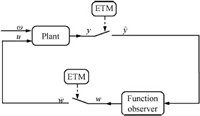
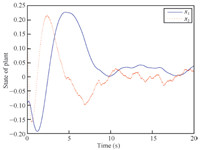
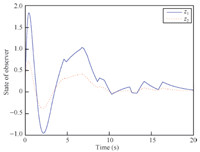
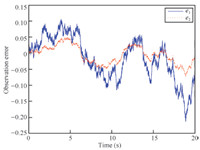
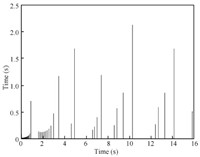
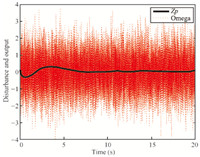
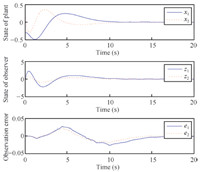
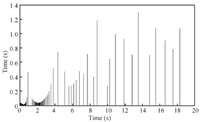
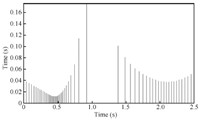
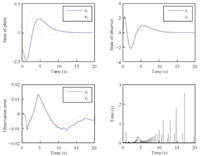
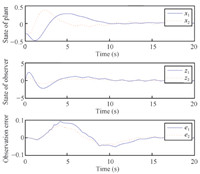
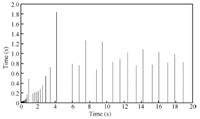
 2015, Vol.2
2015, Vol.2 


